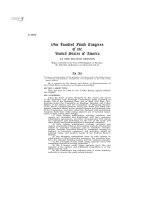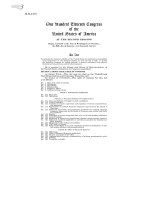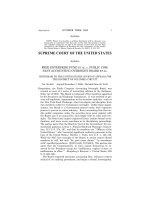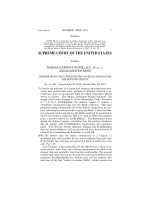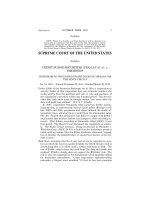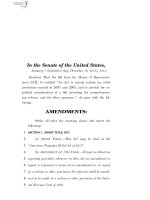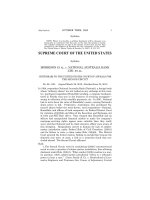Implementation of New Accounting,,Standards of the United States Washington _part4 doc
Bạn đang xem bản rút gọn của tài liệu. Xem và tải ngay bản đầy đủ của tài liệu tại đây (951.08 KB, 11 trang )
B-28204 1
Cash Disbursement Activitv
.
Several major agencies are not effectively reconciling cash disburse-
ments. These reconciliations are intended to be a key control to detect
and correct errors and other misstatements in financial records in a
timely manner-similar in concept to individuals reconciling personal
checkbooks with a bank’s records each month. There continued to be
billions of dollars of unresolved gross differences between agencies’
and Treasury records of cash disbursements as of the end of fiscal year
1998. As a result, the government is unable to ensure that all dis-
bursements are properly recorded. Improperly recorded disburse-
ments could result in misstatements in the financial statements and in
certain data provided by agencies for inclusion in the President’s bud-
get concerning fiscal year 1998 obligationsand outlays.
: Preparation of Financial Statements
The government does not have sufficient systems, controls, or proce-
dures to properly prepare financial statements for the U.S govern-
ment. Such deficiencies, described below, impair the government’s
ability to (1) properly balance the government’s financial statements
and account for billions of dollars of transactions between goverrmren-
tal entities, (2) properly and consistently compile the information in
the financial statements, and (3) effectively reconcile the results of op-
erations reported in the financial statements with budget results.
Unreconciled Transactions. Tq make the financial statements bal-
ance, Treasury recorded a net $24 billion item on the Statement of Op-
erations and Changes in Net Position, -which it labeled unreconciled
transactions. Treasury attributes this net out-of-balance amount to the
government’s inability to properly identify and~eliminate transactions
between federal government entities and to agency adjustments that
affected net position Certain intragovernmental accounts do not rec-
.oncile by a total of more than $250 billion.
Agencies’ accounts can be out of balance with each other, for exam-
ple, when one or the other of the affected agencies does not properly
This is trial version
www.adultpdf.com
28
GENERAL ACCOUNTING OFFICE REPORT
B-282041
record a transaction with another agency or the agencies record the trans-
actions in different accounting periods. These out-of-balance conditions
can be detected and corrected by instituting procedures for reconciling
transactions between agencies on a regular basis and in a timely manner.
Generally, such reconciliations are not performed. These unreconciled
transactions result in material misstatements of assets, liabilities, revenues,
and/or costs.
Financial Statement. Compilation. The federal government cannot ensure
that the information in the financial statements of the U.S. government is
properly and consistently c.ompiled. To prepare the federal government’s
financial statements, about 70 agencies submit data to Treasury on approx-
imately 2,000 separate reporting components, each having many account
balances. .However, several major agencies were unable to provide assur-
ance that all.agency amounts included in’these financial statements recon-
ciled with their agency financial statements. In addition, material adjust-
ments and reclassifications were required to (1) make the financial
statements more consistent with agency financial statements, (2) correct
identified inconsistencies’in refiorting similar transactions, (3) conform
footnote information to related financial statement line items, and (4) re-
cord other audit adjustments.
,.
These problems are compounded by the substantial volume of information
submitted and limitations in the federal government’s general ledger ac-
count”structure. Asa result, additional misclassifications and misstate-
ments in the government’s financial statements could exist.
Reconcilinn the Results bf Ouerations With Budget Results.
The federal
government did not have aLprocess to obtain information to effectively rec-
.oncile the reported $13A billion excess of net cost over revenue and a re-
ported unified budget surplus of $69. billion.
Consequently; it could not
identify all of the items needed to reconcile these amounts.
Certain differ-
ences&e expected to’occur because the~financial statements of the U.S.
government are preparedon the accrual. basis .in accordance with federal
accounting standards, which is a different basis than the budget. Under ac-
crual accounting, transactions are reported when the events giving rise to
the transactions occur, rather than when cash is received or paid. By con-
This is trial version
www.adultpdf.com
GENERAL ACCOUNTING OFFICE REPORT.
29
.’
B-282041
trast, federal budgetary reporting is generally on the cash basis in accor-
dance with accepted budget concepts and policies.
Beginning in fiscal year 1998, major agencies were required by federal ac-
counting standards to reconcile their reported net costs to budget informa-
tion, which could provide a basis for preparing the reconciliation in the
1998 Financial Report of the United States Government. However, signif-
icant amounts reported in certain agency reconciliations, including un-
liquidated obligations and certain other budget information, lacked ade-
quate supporting information and may be unreliable. For example, signifi-
cant weaknesses in Department of Defense (DOD) systems and controls
resulted in reported obligations incurred that may have exceeded available
budget authority for certain appropriations. Further, significant amounts
of Defense transactions were not applied or were incorrectly applied to
specific budget appropriations, which could misstate certain reported bud-
get information. Once the federal government produces reliable financial
statements, an effective reconciliation, could help provide additional assur-
ance of the reliability of budget results.
Because ofthe effects of the material weaknesses discussed below, the
federal government has not maintained~effective internal control to ensure
that (1) transactions are properly recorded, processed, and summarized to
permit the preparation of financial statements and stewardship information
in accordance with federal accounting standards, and assets are safe-
guarded against loss from unauthorized acquisition, use, or disposition and
(2) transactions are executed in accordance with laws governing the use of
budget authority and with other laws and regulations that could have a di-
rect and material effect on the financial statements and other laws, regula-
tions, and governmentwide policies identified by OMB Bulletin 98-08:
Individual agency financial statement audit reports describe the effects of
4 OMB Bulletin 98-08, Audit Reauirements for Federal Financial Statements, August 24, 1998,
as amended January 25,1999.
This is trial version
www.adultpdf.com
30
GENERAL ACCOUNTING OFFICE REPORT
B-282041
such weaknesses on specific agencies and identify additional internal con-
trol weaknesses, some of which are material to individual agencies.
In addition to the material weaknesses related to the deficiencies discussed
in our disclaimer on the financial statements, we found that (1) widespread
and serious computer control weaknesses affect virtually all federal agen-
cies and significantly contribute to many of the material deficiencies dis-
cussed above and (2) material control weaknesses affect the government’s
tax collection activities. Due to the deficiencies noted throughout this re-
port, additional material weaknesses may exist that have not been reported.
Commuter Securitv Weaknesses
Continuing serious and widespread computer security weaknesses are
placing enormous amounts of federal assets at .risk of fraud and misuse, fi-
nancial information at risk of unauthorized,modification or destruction,
sensitive information at ,risk ofinappropriate disclosure, and critical opera-
tions at risk of disruption: Significant computer security weaknesses in
systems that handle the govermnent’s unclassified information have been
reported in each of the major federal agencies.
The ,most serious reported
problem is inadequately restricted access to sensitive data. Other types of
weaknesses pertain to not, adequately segregating duties to help ensure that
people do not conduct unauthorized actions without detection, preventing
unauthorized software from being implemented, and mitigating and re-
covering from unplanned interruptions’in computer service. In today’s
highly computerized and interconnected environment, such weaknesses
are vulnerable to exploitation by’ outside intruders as well as authorized us-
ers with malicious intent. !
The consequences of computer security weaknesses could be devastating
and costly-for instance, placing billions of dollars of payments and col-
lections ‘at risk, of fraud’and iml$iring military operations., Also, identified
weaknesses at federal entities,such as the Internal Revenue Service (IRS),
the HHS’s Health Care Financing Administration, the Social Security Ad-
ministration (SSA), the Department of State, and the Department of Vet-
erans Affairs place tax, medical and other sensitive records at risk of unau-
thorized disclosure, modification, and destruction.
This is trial version
www.adultpdf.com
I
GENERAL ACCOUNTING OFFICE REPORT
3 I’
I
/
B-282041
:
:
The government cannot estimate,the full magnitude of actual damage and
loss resulting from federal computer security weaknesses because it is
likely that many such incidents are either not detected or not reported.
However, GAO and agency reviews and documented incidents, such as the
following, illustrate the potential for negative impacts.
.
Attackers have accessed systems and stolen, modified, and destroyed
both data and software at DOD and shut down entire systems.
l
We have been successful, as part of computer security reviews, in
readily gaining unauthorized access to systems that would allow in-
truders to read, modify, or delete data for whatever purpose they had
in mind. Tests by agencies have revealed similar results.
,.
.
SSA’s IG has reported criminal convictions involving SSA employees,
most of which involved creating fictitious identities, fraudulently sell-
‘, ing SSA cards, misappropriating refunds, or abusing access to confi-
dential information.
I
.
IRS has identified incidents of employees browsing taxpayer data and
inappropriately using other systems containing taxpayer data.
GAO and the IGs have issued numerous reports that’identify information
security .weakriesses in the’federal ,govemment and made recommenda-
.
tions to address them. Also, ‘GAO has reported information security as a
high-risk area across government since February 1997.’ Agencies need to
fully institute a framework for assessing risk and ensuring that necessary
policies and controls are in place and remain effective on an ongoing ba-
sis.
Tax Collection Activities
.’
.,
The federal government’continues to have material weaknesses in controls
related to,itstax collection activities, which affect itsability to efficiently
and effectively account for and collect the government’s revenue. This sit-
uation results in the need for extensive, costly, and time-consuming ad hoc
January 1999), High-Risk Series: An Overview
Series: Information Management and Technol-
o& (GAO/HR-97-9,
This is trial version
www.adultpdf.com
32
GENERAL ACCOUNTING OFFICE REPORT
./ .:
B-28204 1
programming and analysis, as well as material audit adjustments, to pre-
pare basic financial information-an approach that cannot be used to pre-
pare such information on a timely, routine basis to assist in ongoing deci-
sion-making. Additionally, the severity of the system deficiencies that
give rise to the need to resort to such procedures for financial reporting
purposes, as well as deficient physical safeguards, result in burden to tax-
payers and lost revenue.
Serious financial management system deficiencies continue to affect the
federal government’s ability to effectively manage its taxes receivable
and other unpaid assessments.6
The lack of appropriate subsidiary systems
to track the status of taxpayer accounts affects the government’s ability to
make informed decisions about collection efforts. This weakness has re-
sulted in the government pursuing collection efforts against individual tax-
payers who had already paid their taxes in full. The federal government
also continues to be vulnerable to loss of tax revenue due to weaknesses in
preventive controls over disbursements for tax refunds. The government
does not perform sufficient up-front verification procedures to ensure the
.validity of amounts claimed by taxpayers as overpayments prior to making
disbursements for refunds. Additionally, delays in recording tax amounts
owed result in lost opportunities to retain or offset overpayments made by
a taxpayer for one period to collect on outstanding amounts owed for an-
other period, resulting in lost revenue. Finally, serious deficiencies in
physical controls over cash, checks, and sensitive’ data received from tax-
payers increase both the government’s and the taxpayers’ exposure to
losses and increases the risk of taxpayers becoming victims of crimes
committed through identity fraud.
.’
., ’
6 Other unpaid assessments consist of amounts for which (I) neither the taxpayer nor a court has
affirmed are owed ‘or (2) the government does not expect further collections due to factors such
as the taxpayer’s death, bankruptcy, or insolvency.
This is trial version
www.adultpdf.com
GENERAL ACCOUNTING OFFICE REPORT
33
.
/
I
/ :,
B-282041
,
NONCOMPLIANCE WITH
CERTAIN LAWS AND REGULATIONS
Our objective was not to, and we do not, express an opinion on overall
compliance with laws and regulations. Tests for compliance with selected
provisions of laws and regulations related to financial reporting disclosed
that, as discussed earlier, the federal government makes improper pay-
ments in major programs such as Medicare. Additionally, as described be-
low, we noted that federal systems do .not substantially, comply with fed-
eral-financial management systems requirements. We caution that
noncompliance other than that discussed in ‘our report may occur and not
,’
be detected by ,these tests ,and that our limited testing may not be sufficient
for other purposes. Further, the’scope ,of our tests was limited by the ma-
‘.
terial deficiencies discussed above. Other,instances of noncompliance,
some of which,are material to individual federal agencies, are reported in
the individual agency financial statement audit reports.
.‘.*,.
I
Noncomnliance with the Federal ,Financial Management Imnrovement Act
A of 1996
The Federal Financial Management Improvement Act (FFMIA) of 1996
requires auditors .performing financial audits to report whether agencies’
financial management; systems comply substantially with federal account-
ing,standards, financial systems requirements, and the government’s stan-
dard general ledger at the transactionlevel. For fiscal year 1997, agency
,, _,
financial auditors reported that 20 of 24 major agencies’ financial systems
did not comp1.y with the .Act’s,requirements.
Similar results are expected
for fiscal year 1998. ‘Noncompliance with FFMIA? which:we further dis-
cuss in our report, Financial Management: Federal Financial Management
Improvement ;4ct Results for Fiscal Yearl99f (GAO/AIMD-98-268, Sep-
‘. tember 30, 1998), is indicative of-the-overall dontinuing poor condition of
- agency financial systems. : ” !
:
The majority of federal agencies’ financial management’systems do not
meet systems requirements and cannot provide reliable financial informa-
tion for managing day-to-day government operations and holding manag-
This is trial version
www.adultpdf.com
1
34 GENERAL ACCOUNTING OFFICE REPORT
B-282041
em accountable. For many agencies, the preparation of financial state-
ments requires considerable reliance on ad hoc programming and analysis
of data produced by inadequate financial systems that are not integrated,
reconciled, and often require significant adjustments. For example, the
DOD Inspector General reported that the Department recorded more than
$1.5 trillion in adjustments to component financial statements that were
not supported by adequate audit trails ‘or sufficient evidence to determine
their validity. The significant financial management deficiencies dis-
cussed throughout this report underscore the challenge.
YEAR 2000 COMPUTING CHALLENGE
The federal government-with its widespread dependence on large-scale,
complex computer systems to ‘deliver vital public services tid carry out its
massive operations -faces an espeCially enormous and difficult task. Un-
less adequately.confronted; Year 2000 .computing challenges could lead to
serious disruptions in key federal operations, ranging from national de-
fense to benefit payments to air traffic management. Consequently, in
February 1997, GAO’ designated the Year 2000 computing challenge
across government as a high-risk area.
In response to a growing recognition of the challenge and urging from
congressional leaders and others, the administration strengthened the gov-
ernment’s Year 2000 preparation. In February 1998, the President took a
major step in establishing the President’s, Council on Year 2000 Conver-
sion. He’ established the goal that no system critical to,the federal govern-
ment’s mission experience disruption because of the Year 2000 challenge,
and charged agency heads with ensuring that this issue receives the highest
priority attention. ’
,_.
,.’
_I
GAO has issued over 9.0 reports and testimony statements detailing spe-
cific findings and made well over 100 recommendations related to the
Year 2000 readiness of the government as a whole and of a wide range of
individual agencies. In addition, to help agencies mitigate their Year 2000
risk, we’.produced a series of guides 0n.Yea.r 2000 readiness, business con-
tinuity and contingency planning, and testing.
4
This is trial version
www.adultpdf.com
I
GENERAL ACCOUNTING OFFICE REPORT
35
‘/
B-282041
While much has been accomplished in addressing the Year 2000 chal-
lenge, risks remain. Our reviews of federal Year 2000 programs have
found uneven progress; some major agencies are behind schedule. Com-
plete and thorough Year 2000 testing. is essential to providing reasonable
assurance that new.or modified systems will be able to process dates cor-
rectly .and not jeopardize agencies’ ability to perform core business opera-
tions. Moreover, adequate business continuity and contingency plans
must be suc,cessfully completed throughout government.
FINANCIAL STATEMENTS AND BUDGET DECISIONS:
ADDING THE LONG-TERM PERSPECTIVE _’
.
A view of the long-term sustainability of fiscal policies can assist
decisiomnakers‘in considering the government’s financial position and
making decisions about resource allocation Such a view requires projec- ,
5
:‘,tions of spending and,revenues into .fhe future. In this context, the sover-
eign power to tax and the commitments~ of social insurance pro-
i I grams-such as Social Security and Medicare-must, be considered.
. . :
Commitments,for the Social, Security and Medicare programs are included
in the Stewardship Informati,on accompanying the ‘financial statements.
The government’s 75 year estimates of the ,present value of expenditures
in excess of contributions for the Social Security (dld Age. Survivors and
Disability Insurance (OASDI)) and Medicare (Part A) programs amounted
to $3.8 trillion and $4.0 trillion;respectively, as of September 30, 1998.
The government’s projections also indicate that Social Security and health
care costs will absorb an increasing share of,the federal budget.
In fiscal year 1998; Social ~Secu$y trust funds, surpluses of $99 billion off-
&a $30 biilion deficit in the rest, .b~the:budget;‘i;esultilng in the $69 bil-
! lion unified budget surplus. However, as discussed in theaccompanying
,.
: Stewardship Information, using the government’s best estimates as of Sep-
tember’30, ‘1998;; cash,disbursements of the Social Securitytrust funds
(OASDI), tie expected to exceed cash ‘receipts begi&mg~in f&al year
2013. Cash disbursements of Medicare’s Hospital Insurance Program
(Part A) have exceeded receipts for several years.
This is trial version
www.adultpdf.com
/
36
GENERAL ACCOUNTING OFFICE ,REPORT
B-28204 1
,’
When receipts exceed disbursements, trust funds invest the surplus in
Treasury securities, which are assets to the trust funds and liabilities to the
Treasury. As disclosed in note 9 and 17, both the investments and liabili-
ties, which amounted to $1.8 trillion at September 30, 1998, are netted out
in the accompanying financial statements.
Expected cash shortfalls in the trust funds will require them to redeem
their investments in Treasury securities. When this occurs, the govern-
ment must fund, these redemptions through use of future surpluses if avail-
able, lower relative spending for other federal programs, higher relative
taxes, and/or greater relative borrowing from the public. Further, under
the government’s September 30,1998 projections, absent any program or
financing change, the Medicare Part A Trust Fund and Social Security
trust funds will exhaust their Treasury security holdings in 2008 and 2032,
respectively.
There is general ‘recognition that the Social Security and Medicare Hospi-
tal Insurance (Part A) programs require changes from their current form.
This is why today various proposals are being considered to deal with the
long-term solvency and sustainability of these two programs.
The fact that
Medicare is already drawing down its Treasury securities holdings, and
that it is expected that Social Security will need to do so in less than 15
years, highlights the importance of acting soon in order to avoid more dra-
matic changes in the future.
We are. working with OMB, the Treasury, and other’agencies across gov-
ernment to provide recommendations for fixing the major deficiencies
cited in .our audit.
Considerable effort is now being exerted to address the
problems, and several agencies, such as SSA, have made good progress to-
ward achieving, financial management reform goals.
We have designated
the,most serious situations as high-risk, including financial management at
DOD, IRS, the Forest Service, and the Federal Aviation Administration, as
well as information security and the Year 2000 challenge.
This is trial version
www.adultpdf.com
il
GENERAL ACCOUNTING OFFICE REPORT 37
r
B-282041
In addition, the continued coordinated efforts of Treasury and OMB will
be required to provide solutions for certain governmentwide deficiencies,
such as the inability to properly identify and eliminate transactions be-
tween federal entities and the compilation of the ~financial statements. We
will continue to provide suggestions for resolving governmentwide prob-
lems, and to evaluate progress in overcoming them.
David M. Walker
Com@roller General
of the United States
March 19,1999
‘,,,
:
,’
(,
1
This is trial version
www.adultpdf.com
